Evaluating the Effectiveness of Early Save Programs in Hospitals
VerifiedAdded on 2020/05/11
|8
|1924
|373
Report
AI Summary
This report provides an evidence-based analysis of an Early Save Program, evaluating its effectiveness in diagnosing and managing severe medical emergencies within a hospital setting. The analysis compares pre- and post-program data, focusing on factors such as MET processes, patient outcomes (including mortality, ICU/HDU transfers, and ward stays), and adherence to NSQHS Standard 9. The report also examines the role of non-technical skills, access to support, and family presence during resuscitation, discussing staff attitudes, ethical considerations, and the impact on patient care. It concludes with recommendations for improving the program, highlighting the importance of clinical staff's role in resuscitation and the potential benefits and drawbacks of family presence, advocating for a prohibition on family presence during resuscitation to ensure clinical staff can focus on saving the patient's life.
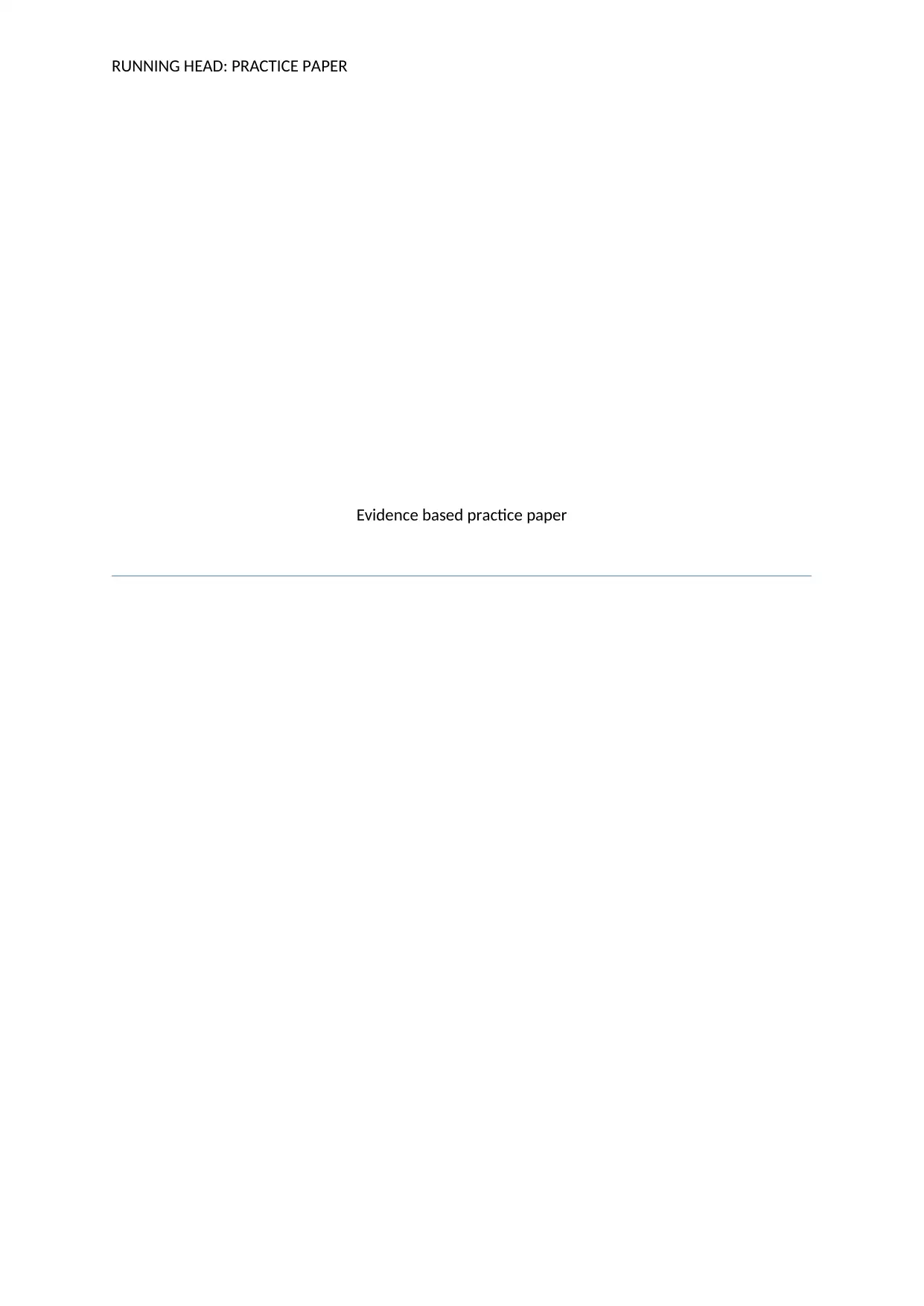
RUNNING HEAD: PRACTICE PAPER
Evidence based practice paper
Evidence based practice paper
Paraphrase This Document
Need a fresh take? Get an instant paraphrase of this document with our AI Paraphraser

PRACTICE PAPER 1
Contents
Part 1..........................................................................................................................................2
Part 2..........................................................................................................................................4
References..................................................................................................................................7
Contents
Part 1..........................................................................................................................................2
Part 2..........................................................................................................................................4
References..................................................................................................................................7
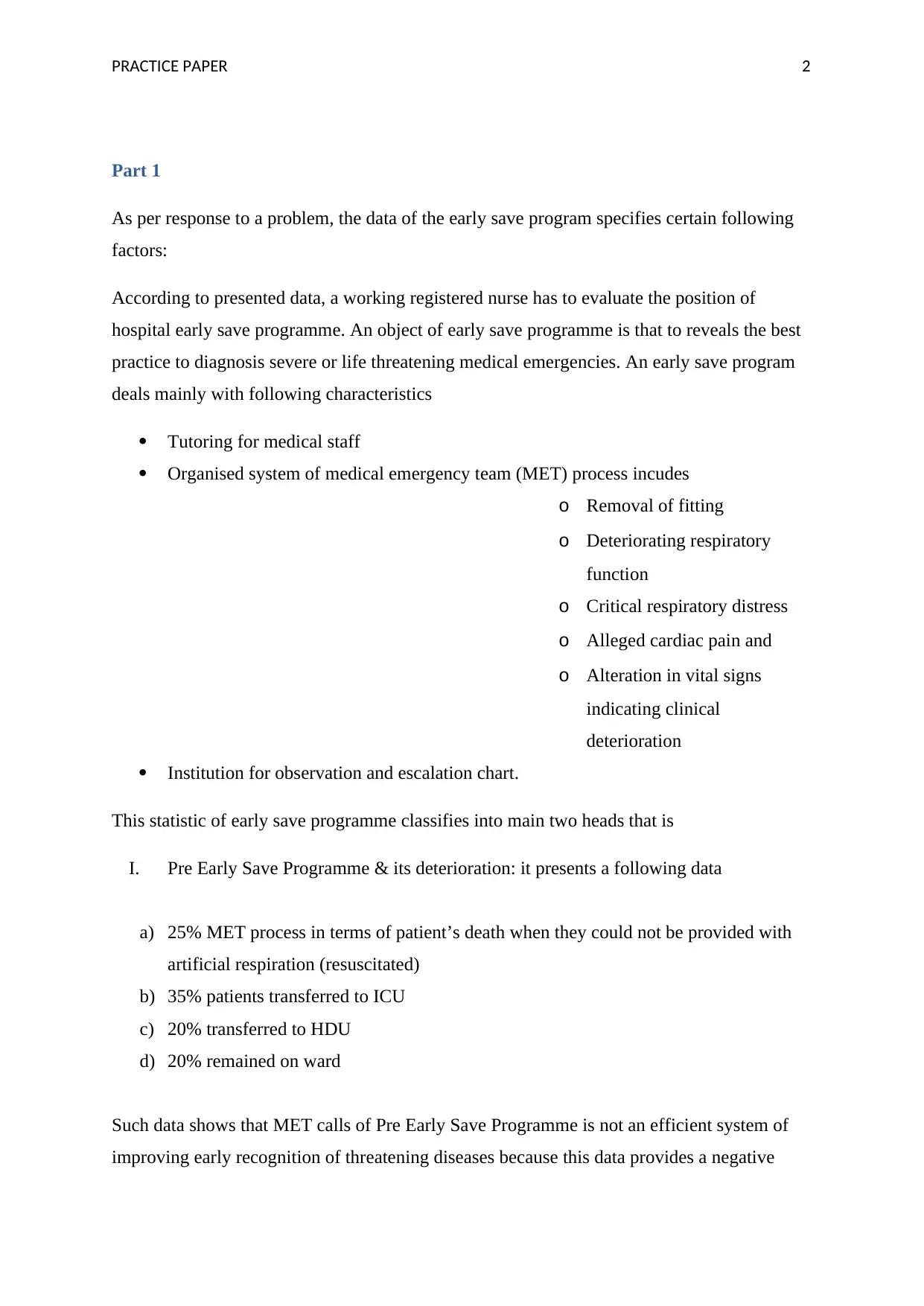
PRACTICE PAPER 2
Part 1
As per response to a problem, the data of the early save program specifies certain following
factors:
According to presented data, a working registered nurse has to evaluate the position of
hospital early save programme. An object of early save programme is that to reveals the best
practice to diagnosis severe or life threatening medical emergencies. An early save program
deals mainly with following characteristics
Tutoring for medical staff
Organised system of medical emergency team (MET) process incudes
o Removal of fitting
o Deteriorating respiratory
function
o Critical respiratory distress
o Alleged cardiac pain and
o Alteration in vital signs
indicating clinical
deterioration
Institution for observation and escalation chart.
This statistic of early save programme classifies into main two heads that is
I. Pre Early Save Programme & its deterioration: it presents a following data
a) 25% MET process in terms of patient’s death when they could not be provided with
artificial respiration (resuscitated)
b) 35% patients transferred to ICU
c) 20% transferred to HDU
d) 20% remained on ward
Such data shows that MET calls of Pre Early Save Programme is not an efficient system of
improving early recognition of threatening diseases because this data provides a negative
Part 1
As per response to a problem, the data of the early save program specifies certain following
factors:
According to presented data, a working registered nurse has to evaluate the position of
hospital early save programme. An object of early save programme is that to reveals the best
practice to diagnosis severe or life threatening medical emergencies. An early save program
deals mainly with following characteristics
Tutoring for medical staff
Organised system of medical emergency team (MET) process incudes
o Removal of fitting
o Deteriorating respiratory
function
o Critical respiratory distress
o Alleged cardiac pain and
o Alteration in vital signs
indicating clinical
deterioration
Institution for observation and escalation chart.
This statistic of early save programme classifies into main two heads that is
I. Pre Early Save Programme & its deterioration: it presents a following data
a) 25% MET process in terms of patient’s death when they could not be provided with
artificial respiration (resuscitated)
b) 35% patients transferred to ICU
c) 20% transferred to HDU
d) 20% remained on ward
Such data shows that MET calls of Pre Early Save Programme is not an efficient system of
improving early recognition of threatening diseases because this data provides a negative
⊘ This is a preview!⊘
Do you want full access?
Subscribe today to unlock all pages.

Trusted by 1+ million students worldwide
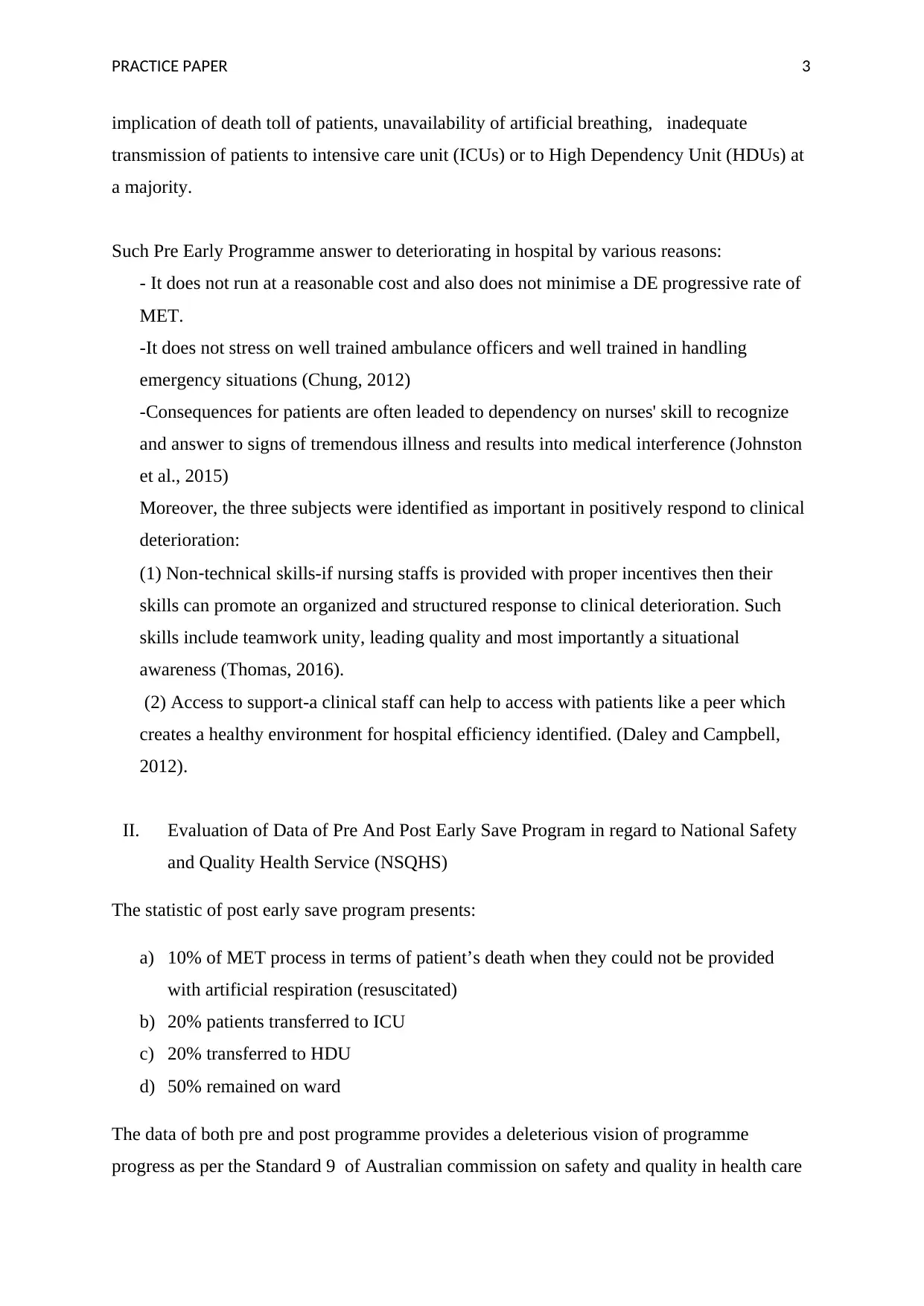
PRACTICE PAPER 3
implication of death toll of patients, unavailability of artificial breathing, inadequate
transmission of patients to intensive care unit (ICUs) or to High Dependency Unit (HDUs) at
a majority.
Such Pre Early Programme answer to deteriorating in hospital by various reasons:
- It does not run at a reasonable cost and also does not minimise a DE progressive rate of
MET.
-It does not stress on well trained ambulance officers and well trained in handling
emergency situations (Chung, 2012)
-Consequences for patients are often leaded to dependency on nurses' skill to recognize
and answer to signs of tremendous illness and results into medical interference (Johnston
et al., 2015)
Moreover, the three subjects were identified as important in positively respond to clinical
deterioration:
(1) Non‐technical skills-if nursing staffs is provided with proper incentives then their
skills can promote an organized and structured response to clinical deterioration. Such
skills include teamwork unity, leading quality and most importantly a situational
awareness (Thomas, 2016).
(2) Access to support-a clinical staff can help to access with patients like a peer which
creates a healthy environment for hospital efficiency identified. (Daley and Campbell,
2012).
II. Evaluation of Data of Pre And Post Early Save Program in regard to National Safety
and Quality Health Service (NSQHS)
The statistic of post early save program presents:
a) 10% of MET process in terms of patient’s death when they could not be provided
with artificial respiration (resuscitated)
b) 20% patients transferred to ICU
c) 20% transferred to HDU
d) 50% remained on ward
The data of both pre and post programme provides a deleterious vision of programme
progress as per the Standard 9 of Australian commission on safety and quality in health care
implication of death toll of patients, unavailability of artificial breathing, inadequate
transmission of patients to intensive care unit (ICUs) or to High Dependency Unit (HDUs) at
a majority.
Such Pre Early Programme answer to deteriorating in hospital by various reasons:
- It does not run at a reasonable cost and also does not minimise a DE progressive rate of
MET.
-It does not stress on well trained ambulance officers and well trained in handling
emergency situations (Chung, 2012)
-Consequences for patients are often leaded to dependency on nurses' skill to recognize
and answer to signs of tremendous illness and results into medical interference (Johnston
et al., 2015)
Moreover, the three subjects were identified as important in positively respond to clinical
deterioration:
(1) Non‐technical skills-if nursing staffs is provided with proper incentives then their
skills can promote an organized and structured response to clinical deterioration. Such
skills include teamwork unity, leading quality and most importantly a situational
awareness (Thomas, 2016).
(2) Access to support-a clinical staff can help to access with patients like a peer which
creates a healthy environment for hospital efficiency identified. (Daley and Campbell,
2012).
II. Evaluation of Data of Pre And Post Early Save Program in regard to National Safety
and Quality Health Service (NSQHS)
The statistic of post early save program presents:
a) 10% of MET process in terms of patient’s death when they could not be provided
with artificial respiration (resuscitated)
b) 20% patients transferred to ICU
c) 20% transferred to HDU
d) 50% remained on ward
The data of both pre and post programme provides a deleterious vision of programme
progress as per the Standard 9 of Australian commission on safety and quality in health care
Paraphrase This Document
Need a fresh take? Get an instant paraphrase of this document with our AI Paraphraser
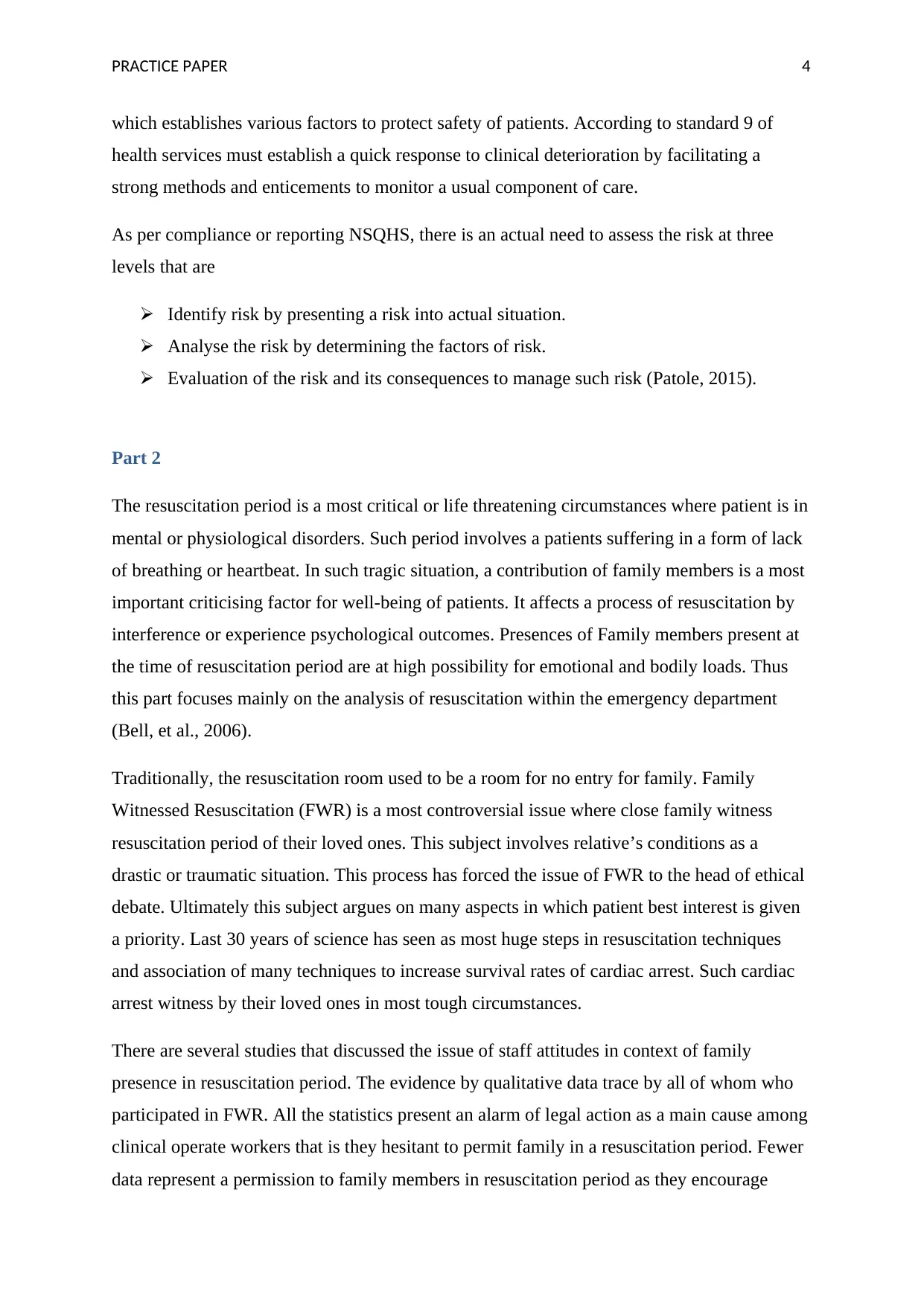
PRACTICE PAPER 4
which establishes various factors to protect safety of patients. According to standard 9 of
health services must establish a quick response to clinical deterioration by facilitating a
strong methods and enticements to monitor a usual component of care.
As per compliance or reporting NSQHS, there is an actual need to assess the risk at three
levels that are
Identify risk by presenting a risk into actual situation.
Analyse the risk by determining the factors of risk.
Evaluation of the risk and its consequences to manage such risk (Patole, 2015).
Part 2
The resuscitation period is a most critical or life threatening circumstances where patient is in
mental or physiological disorders. Such period involves a patients suffering in a form of lack
of breathing or heartbeat. In such tragic situation, a contribution of family members is a most
important criticising factor for well-being of patients. It affects a process of resuscitation by
interference or experience psychological outcomes. Presences of Family members present at
the time of resuscitation period are at high possibility for emotional and bodily loads. Thus
this part focuses mainly on the analysis of resuscitation within the emergency department
(Bell, et al., 2006).
Traditionally, the resuscitation room used to be a room for no entry for family. Family
Witnessed Resuscitation (FWR) is a most controversial issue where close family witness
resuscitation period of their loved ones. This subject involves relative’s conditions as a
drastic or traumatic situation. This process has forced the issue of FWR to the head of ethical
debate. Ultimately this subject argues on many aspects in which patient best interest is given
a priority. Last 30 years of science has seen as most huge steps in resuscitation techniques
and association of many techniques to increase survival rates of cardiac arrest. Such cardiac
arrest witness by their loved ones in most tough circumstances.
There are several studies that discussed the issue of staff attitudes in context of family
presence in resuscitation period. The evidence by qualitative data trace by all of whom who
participated in FWR. All the statistics present an alarm of legal action as a main cause among
clinical operate workers that is they hesitant to permit family in a resuscitation period. Fewer
data represent a permission to family members in resuscitation period as they encourage
which establishes various factors to protect safety of patients. According to standard 9 of
health services must establish a quick response to clinical deterioration by facilitating a
strong methods and enticements to monitor a usual component of care.
As per compliance or reporting NSQHS, there is an actual need to assess the risk at three
levels that are
Identify risk by presenting a risk into actual situation.
Analyse the risk by determining the factors of risk.
Evaluation of the risk and its consequences to manage such risk (Patole, 2015).
Part 2
The resuscitation period is a most critical or life threatening circumstances where patient is in
mental or physiological disorders. Such period involves a patients suffering in a form of lack
of breathing or heartbeat. In such tragic situation, a contribution of family members is a most
important criticising factor for well-being of patients. It affects a process of resuscitation by
interference or experience psychological outcomes. Presences of Family members present at
the time of resuscitation period are at high possibility for emotional and bodily loads. Thus
this part focuses mainly on the analysis of resuscitation within the emergency department
(Bell, et al., 2006).
Traditionally, the resuscitation room used to be a room for no entry for family. Family
Witnessed Resuscitation (FWR) is a most controversial issue where close family witness
resuscitation period of their loved ones. This subject involves relative’s conditions as a
drastic or traumatic situation. This process has forced the issue of FWR to the head of ethical
debate. Ultimately this subject argues on many aspects in which patient best interest is given
a priority. Last 30 years of science has seen as most huge steps in resuscitation techniques
and association of many techniques to increase survival rates of cardiac arrest. Such cardiac
arrest witness by their loved ones in most tough circumstances.
There are several studies that discussed the issue of staff attitudes in context of family
presence in resuscitation period. The evidence by qualitative data trace by all of whom who
participated in FWR. All the statistics present an alarm of legal action as a main cause among
clinical operate workers that is they hesitant to permit family in a resuscitation period. Fewer
data represent a permission to family members in resuscitation period as they encourage
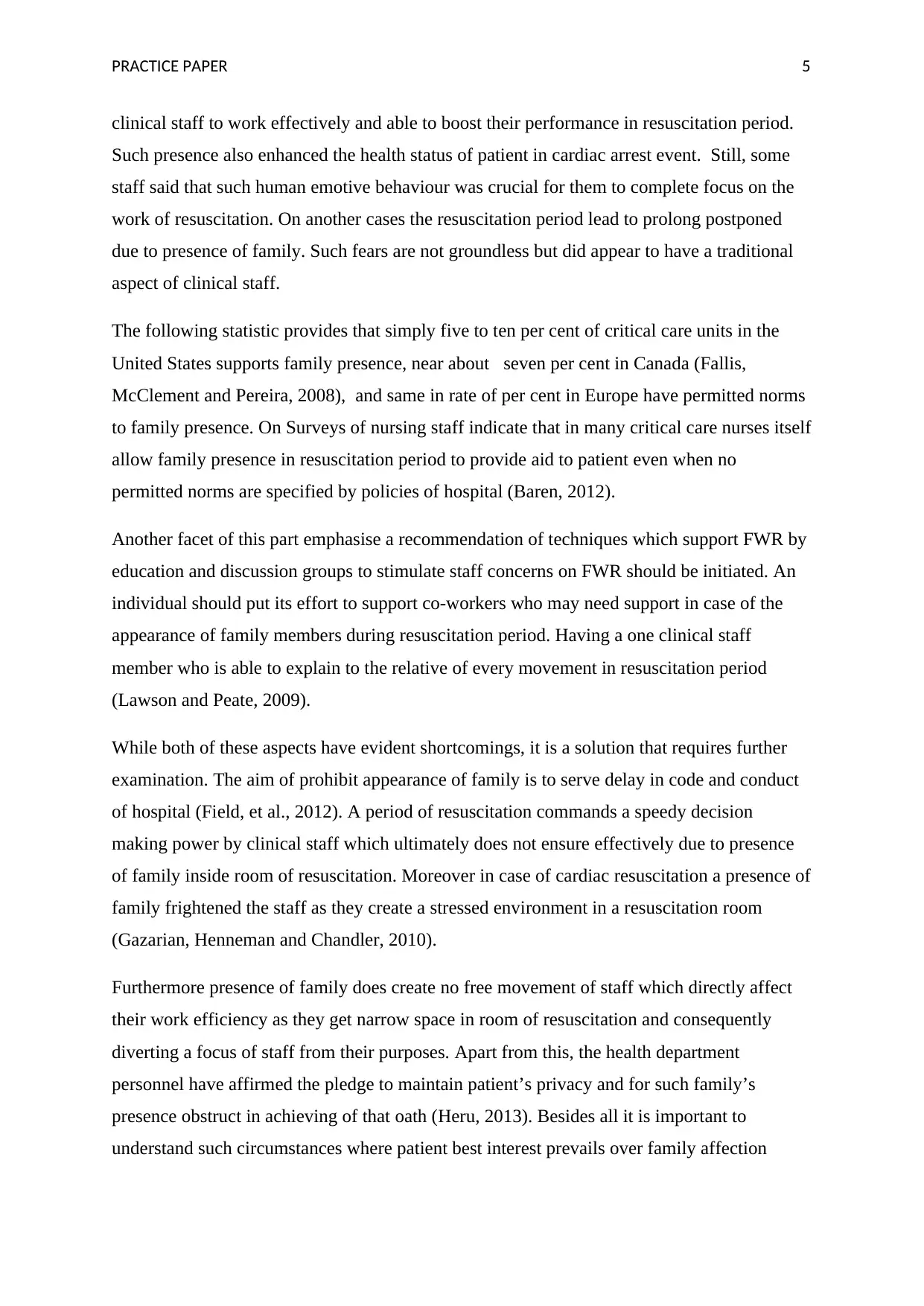
PRACTICE PAPER 5
clinical staff to work effectively and able to boost their performance in resuscitation period.
Such presence also enhanced the health status of patient in cardiac arrest event. Still, some
staff said that such human emotive behaviour was crucial for them to complete focus on the
work of resuscitation. On another cases the resuscitation period lead to prolong postponed
due to presence of family. Such fears are not groundless but did appear to have a traditional
aspect of clinical staff.
The following statistic provides that simply five to ten per cent of critical care units in the
United States supports family presence, near about seven per cent in Canada (Fallis,
McClement and Pereira, 2008), and same in rate of per cent in Europe have permitted norms
to family presence. On Surveys of nursing staff indicate that in many critical care nurses itself
allow family presence in resuscitation period to provide aid to patient even when no
permitted norms are specified by policies of hospital (Baren, 2012).
Another facet of this part emphasise a recommendation of techniques which support FWR by
education and discussion groups to stimulate staff concerns on FWR should be initiated. An
individual should put its effort to support co-workers who may need support in case of the
appearance of family members during resuscitation period. Having a one clinical staff
member who is able to explain to the relative of every movement in resuscitation period
(Lawson and Peate, 2009).
While both of these aspects have evident shortcomings, it is a solution that requires further
examination. The aim of prohibit appearance of family is to serve delay in code and conduct
of hospital (Field, et al., 2012). A period of resuscitation commands a speedy decision
making power by clinical staff which ultimately does not ensure effectively due to presence
of family inside room of resuscitation. Moreover in case of cardiac resuscitation a presence of
family frightened the staff as they create a stressed environment in a resuscitation room
(Gazarian, Henneman and Chandler, 2010).
Furthermore presence of family does create no free movement of staff which directly affect
their work efficiency as they get narrow space in room of resuscitation and consequently
diverting a focus of staff from their purposes. Apart from this, the health department
personnel have affirmed the pledge to maintain patient’s privacy and for such family’s
presence obstruct in achieving of that oath (Heru, 2013). Besides all it is important to
understand such circumstances where patient best interest prevails over family affection
clinical staff to work effectively and able to boost their performance in resuscitation period.
Such presence also enhanced the health status of patient in cardiac arrest event. Still, some
staff said that such human emotive behaviour was crucial for them to complete focus on the
work of resuscitation. On another cases the resuscitation period lead to prolong postponed
due to presence of family. Such fears are not groundless but did appear to have a traditional
aspect of clinical staff.
The following statistic provides that simply five to ten per cent of critical care units in the
United States supports family presence, near about seven per cent in Canada (Fallis,
McClement and Pereira, 2008), and same in rate of per cent in Europe have permitted norms
to family presence. On Surveys of nursing staff indicate that in many critical care nurses itself
allow family presence in resuscitation period to provide aid to patient even when no
permitted norms are specified by policies of hospital (Baren, 2012).
Another facet of this part emphasise a recommendation of techniques which support FWR by
education and discussion groups to stimulate staff concerns on FWR should be initiated. An
individual should put its effort to support co-workers who may need support in case of the
appearance of family members during resuscitation period. Having a one clinical staff
member who is able to explain to the relative of every movement in resuscitation period
(Lawson and Peate, 2009).
While both of these aspects have evident shortcomings, it is a solution that requires further
examination. The aim of prohibit appearance of family is to serve delay in code and conduct
of hospital (Field, et al., 2012). A period of resuscitation commands a speedy decision
making power by clinical staff which ultimately does not ensure effectively due to presence
of family inside room of resuscitation. Moreover in case of cardiac resuscitation a presence of
family frightened the staff as they create a stressed environment in a resuscitation room
(Gazarian, Henneman and Chandler, 2010).
Furthermore presence of family does create no free movement of staff which directly affect
their work efficiency as they get narrow space in room of resuscitation and consequently
diverting a focus of staff from their purposes. Apart from this, the health department
personnel have affirmed the pledge to maintain patient’s privacy and for such family’s
presence obstruct in achieving of that oath (Heru, 2013). Besides all it is important to
understand such circumstances where patient best interest prevails over family affection
⊘ This is a preview!⊘
Do you want full access?
Subscribe today to unlock all pages.

Trusted by 1+ million students worldwide
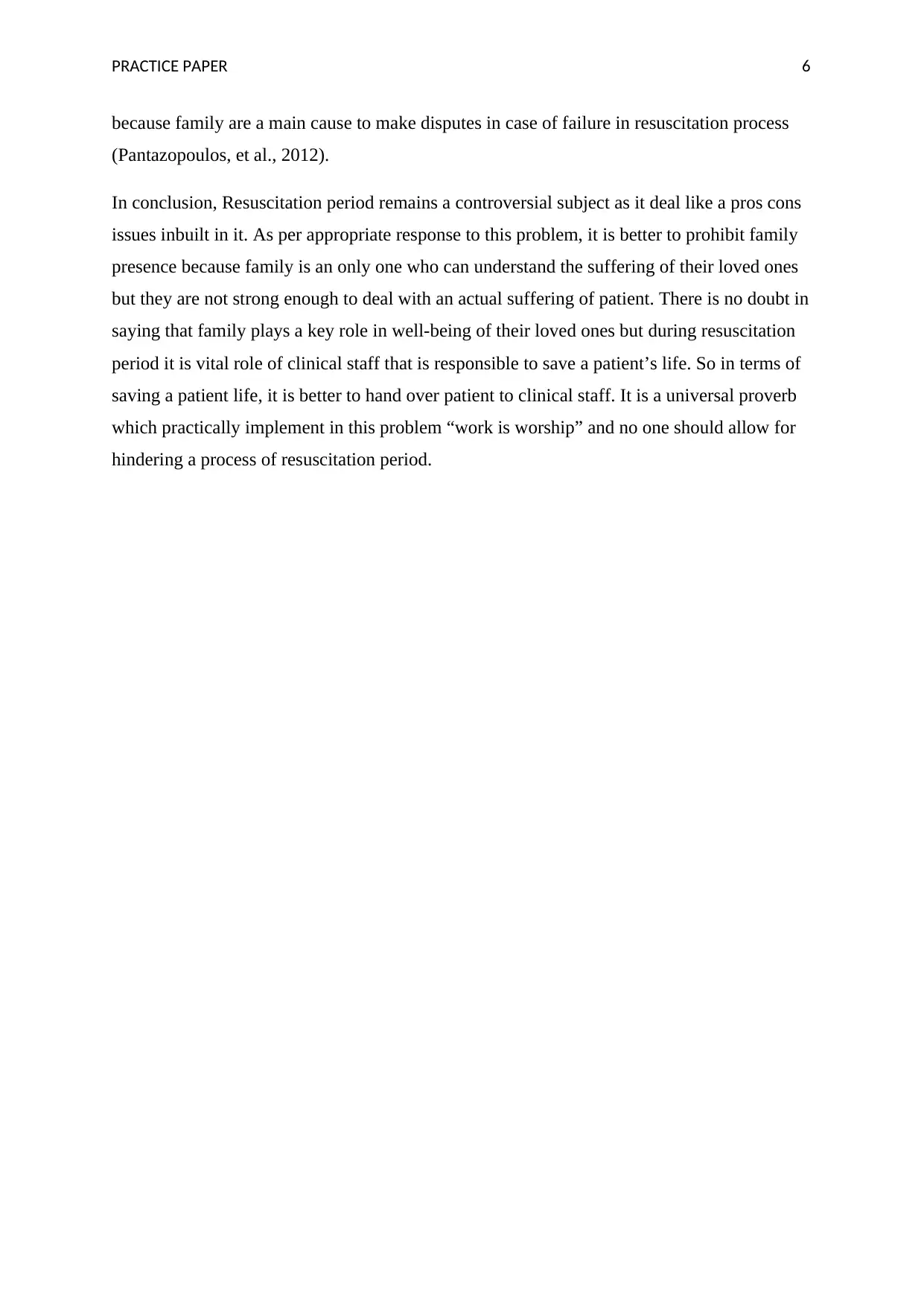
PRACTICE PAPER 6
because family are a main cause to make disputes in case of failure in resuscitation process
(Pantazopoulos, et al., 2012).
In conclusion, Resuscitation period remains a controversial subject as it deal like a pros cons
issues inbuilt in it. As per appropriate response to this problem, it is better to prohibit family
presence because family is an only one who can understand the suffering of their loved ones
but they are not strong enough to deal with an actual suffering of patient. There is no doubt in
saying that family plays a key role in well-being of their loved ones but during resuscitation
period it is vital role of clinical staff that is responsible to save a patient’s life. So in terms of
saving a patient life, it is better to hand over patient to clinical staff. It is a universal proverb
which practically implement in this problem “work is worship” and no one should allow for
hindering a process of resuscitation period.
because family are a main cause to make disputes in case of failure in resuscitation process
(Pantazopoulos, et al., 2012).
In conclusion, Resuscitation period remains a controversial subject as it deal like a pros cons
issues inbuilt in it. As per appropriate response to this problem, it is better to prohibit family
presence because family is an only one who can understand the suffering of their loved ones
but they are not strong enough to deal with an actual suffering of patient. There is no doubt in
saying that family plays a key role in well-being of their loved ones but during resuscitation
period it is vital role of clinical staff that is responsible to save a patient’s life. So in terms of
saving a patient life, it is better to hand over patient to clinical staff. It is a universal proverb
which practically implement in this problem “work is worship” and no one should allow for
hindering a process of resuscitation period.
Paraphrase This Document
Need a fresh take? Get an instant paraphrase of this document with our AI Paraphraser
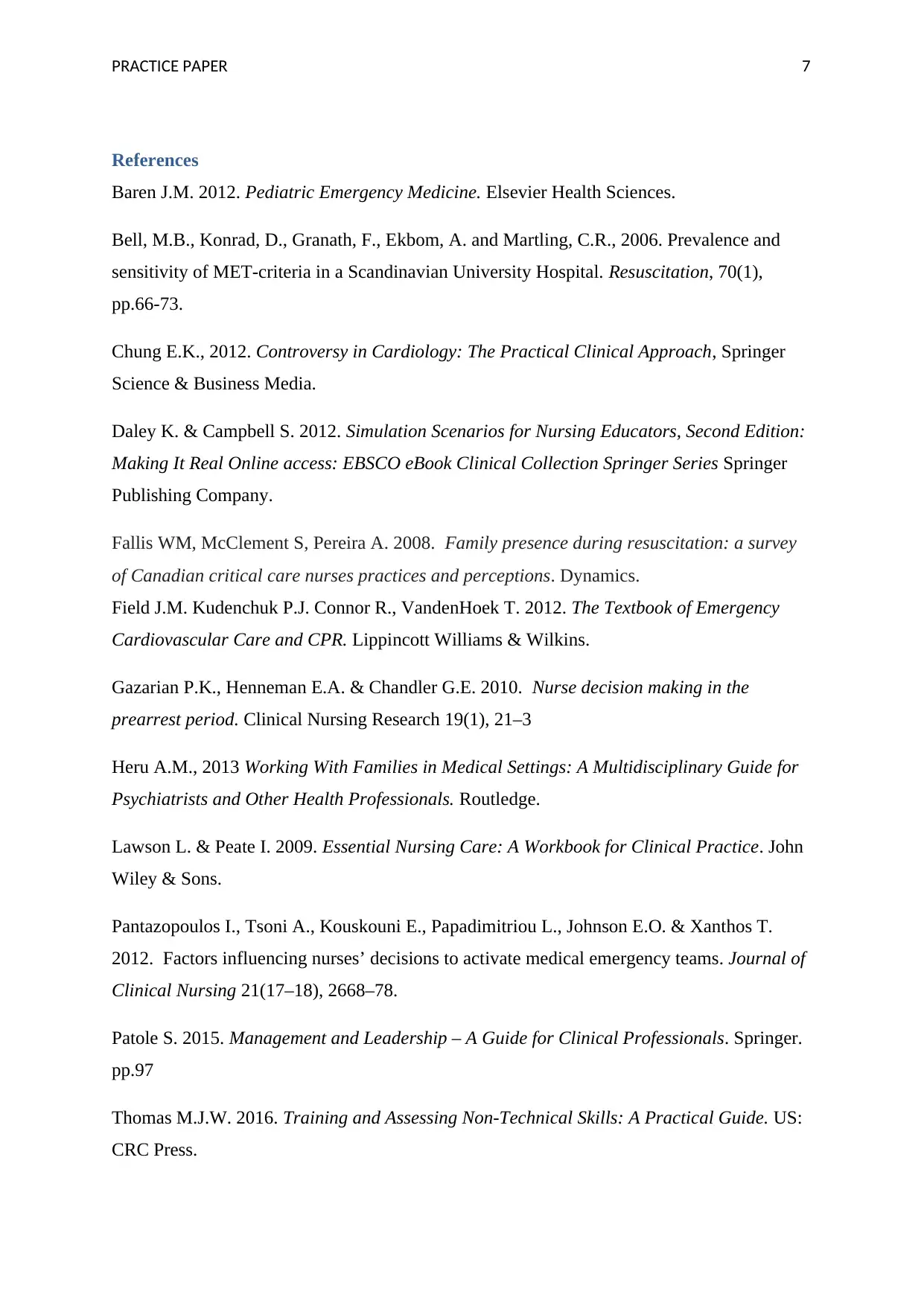
PRACTICE PAPER 7
References
Baren J.M. 2012. Pediatric Emergency Medicine. Elsevier Health Sciences.
Bell, M.B., Konrad, D., Granath, F., Ekbom, A. and Martling, C.R., 2006. Prevalence and
sensitivity of MET-criteria in a Scandinavian University Hospital. Resuscitation, 70(1),
pp.66-73.
Chung E.K., 2012. Controversy in Cardiology: The Practical Clinical Approach, Springer
Science & Business Media.
Daley K. & Campbell S. 2012. Simulation Scenarios for Nursing Educators, Second Edition:
Making It Real Online access: EBSCO eBook Clinical Collection Springer Series Springer
Publishing Company.
Fallis WM, McClement S, Pereira A. 2008. Family presence during resuscitation: a survey
of Canadian critical care nurses practices and perceptions. Dynamics.
Field J.M. Kudenchuk P.J. Connor R., VandenHoek T. 2012. The Textbook of Emergency
Cardiovascular Care and CPR. Lippincott Williams & Wilkins.
Gazarian P.K., Henneman E.A. & Chandler G.E. 2010. Nurse decision making in the
prearrest period. Clinical Nursing Research 19(1), 21–3
Heru A.M., 2013 Working With Families in Medical Settings: A Multidisciplinary Guide for
Psychiatrists and Other Health Professionals. Routledge.
Lawson L. & Peate I. 2009. Essential Nursing Care: A Workbook for Clinical Practice. John
Wiley & Sons.
Pantazopoulos I., Tsoni A., Kouskouni E., Papadimitriou L., Johnson E.O. & Xanthos T.
2012. Factors influencing nurses’ decisions to activate medical emergency teams. Journal of
Clinical Nursing 21(17–18), 2668–78.
Patole S. 2015. Management and Leadership – A Guide for Clinical Professionals. Springer.
pp.97
Thomas M.J.W. 2016. Training and Assessing Non-Technical Skills: A Practical Guide. US:
CRC Press.
References
Baren J.M. 2012. Pediatric Emergency Medicine. Elsevier Health Sciences.
Bell, M.B., Konrad, D., Granath, F., Ekbom, A. and Martling, C.R., 2006. Prevalence and
sensitivity of MET-criteria in a Scandinavian University Hospital. Resuscitation, 70(1),
pp.66-73.
Chung E.K., 2012. Controversy in Cardiology: The Practical Clinical Approach, Springer
Science & Business Media.
Daley K. & Campbell S. 2012. Simulation Scenarios for Nursing Educators, Second Edition:
Making It Real Online access: EBSCO eBook Clinical Collection Springer Series Springer
Publishing Company.
Fallis WM, McClement S, Pereira A. 2008. Family presence during resuscitation: a survey
of Canadian critical care nurses practices and perceptions. Dynamics.
Field J.M. Kudenchuk P.J. Connor R., VandenHoek T. 2012. The Textbook of Emergency
Cardiovascular Care and CPR. Lippincott Williams & Wilkins.
Gazarian P.K., Henneman E.A. & Chandler G.E. 2010. Nurse decision making in the
prearrest period. Clinical Nursing Research 19(1), 21–3
Heru A.M., 2013 Working With Families in Medical Settings: A Multidisciplinary Guide for
Psychiatrists and Other Health Professionals. Routledge.
Lawson L. & Peate I. 2009. Essential Nursing Care: A Workbook for Clinical Practice. John
Wiley & Sons.
Pantazopoulos I., Tsoni A., Kouskouni E., Papadimitriou L., Johnson E.O. & Xanthos T.
2012. Factors influencing nurses’ decisions to activate medical emergency teams. Journal of
Clinical Nursing 21(17–18), 2668–78.
Patole S. 2015. Management and Leadership – A Guide for Clinical Professionals. Springer.
pp.97
Thomas M.J.W. 2016. Training and Assessing Non-Technical Skills: A Practical Guide. US:
CRC Press.
1 out of 8
Related Documents
Your All-in-One AI-Powered Toolkit for Academic Success.
+13062052269
info@desklib.com
Available 24*7 on WhatsApp / Email
![[object Object]](/_next/static/media/star-bottom.7253800d.svg)
Unlock your academic potential
Copyright © 2020–2025 A2Z Services. All Rights Reserved. Developed and managed by ZUCOL.





